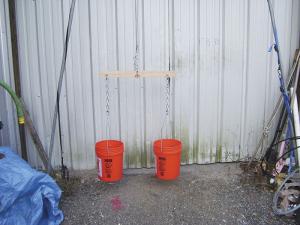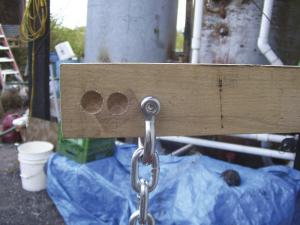2012 - Volume #36, Issue #1, Page #19
[ Sample Stories From This Issue | List of All Stories In This Issue | Print this story
| Read this issue]
Homemade Beam Scale Is Accurate
 |
 |
Carrier’s parts list includes a 1 by 3-in. oak board 30 in. long, 3 shackles that fit over the board, 3 ft. of #4 chain that the shackles will fit through and a small 2-in. level that can be glued to the board. A pointer wire is also needed, which can be made from a perfectly straight piece of electrical wire or a coat hanger.
Carrier built his scale because he needed an extremely accurate and repeatable device for measuring chemicals that he uses in his home-built biodiesel processor. “Every electronic scale I tried was off by 2 to 10 pounds and that didn’t cut it for what I needed,” he said.
To build the scale, Carrier first measured the size of the cleave bolt and drilled a hole that size exactly in the center of the oak board, left to right and top to bottom. He stresses that the bolt has to slide easily through the hole, but can’t be loose from side to side. He drilled the same size holes for each of the side cleave pins 2 in. in from the ends of the boards, again exactly in the center.
Next he attached the level to the board beneath the center hole so the centerline of the level was exactly in the middle of the hole.
Carrier cut the chain into three equal lengths and made two hooks for the bottom of the side chains to hold the material pails. After attaching the side chains to the board with two shackles, he attached the third chain with one shackle to the hole in the center of the board. Carrier said the center chain could be attached to a ceiling beam or anything that will hold 100 lbs. without sagging.
Carrier bought two new buckets to hold material that he weighs. He replaced the wire handles with sturdier handles that he made from threaded 1/4-in. rod that won’t bend, making sure that both handles were the exact size.
After assembling all the parts Carrier balanced the scale by drilling a small amount of wood from one side of the beam. He made 5 and 10-lb. weight ballast by putting sand in old pant leg material and sewing the ends shut. Asked how he was sure the weight on the ‘sand legs’ was accurate, he took a pail of fine sand into a post office after hours and weighed it on their postal scale. He also uses 1/2 and l-lb. wheel weights for counterbalance.
Carrier’s scale is an important part of his homemade biodiesel processing system. He uses it to weigh dry chemicals that have to be added in very exact amounts. He says his scale is a lot easier to use than a bathroom scale or other electronic scales, which are hard to read and inaccurate.
Contact: FARM SHOW Followup, Richard Carrier, 15840 Wimauma Rd., Wimauma, Fla. 33598 (ph 813 545-9361; harveyking@hotmail.com).

Click here to download page story appeared in.

Click here to read entire issue
To read the rest of this story, download this issue below or click here to register with your account number.




